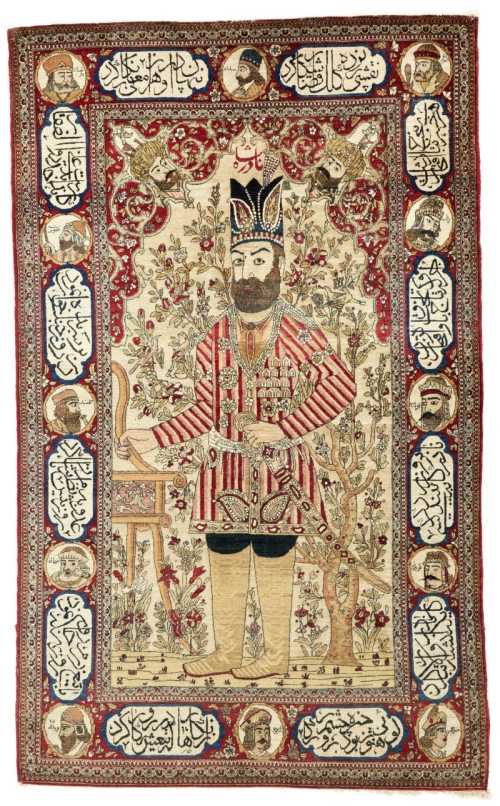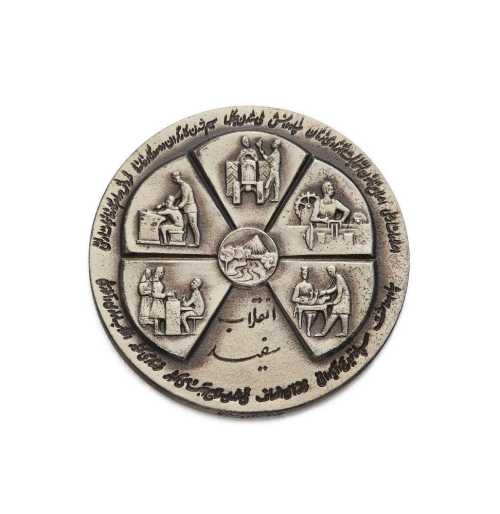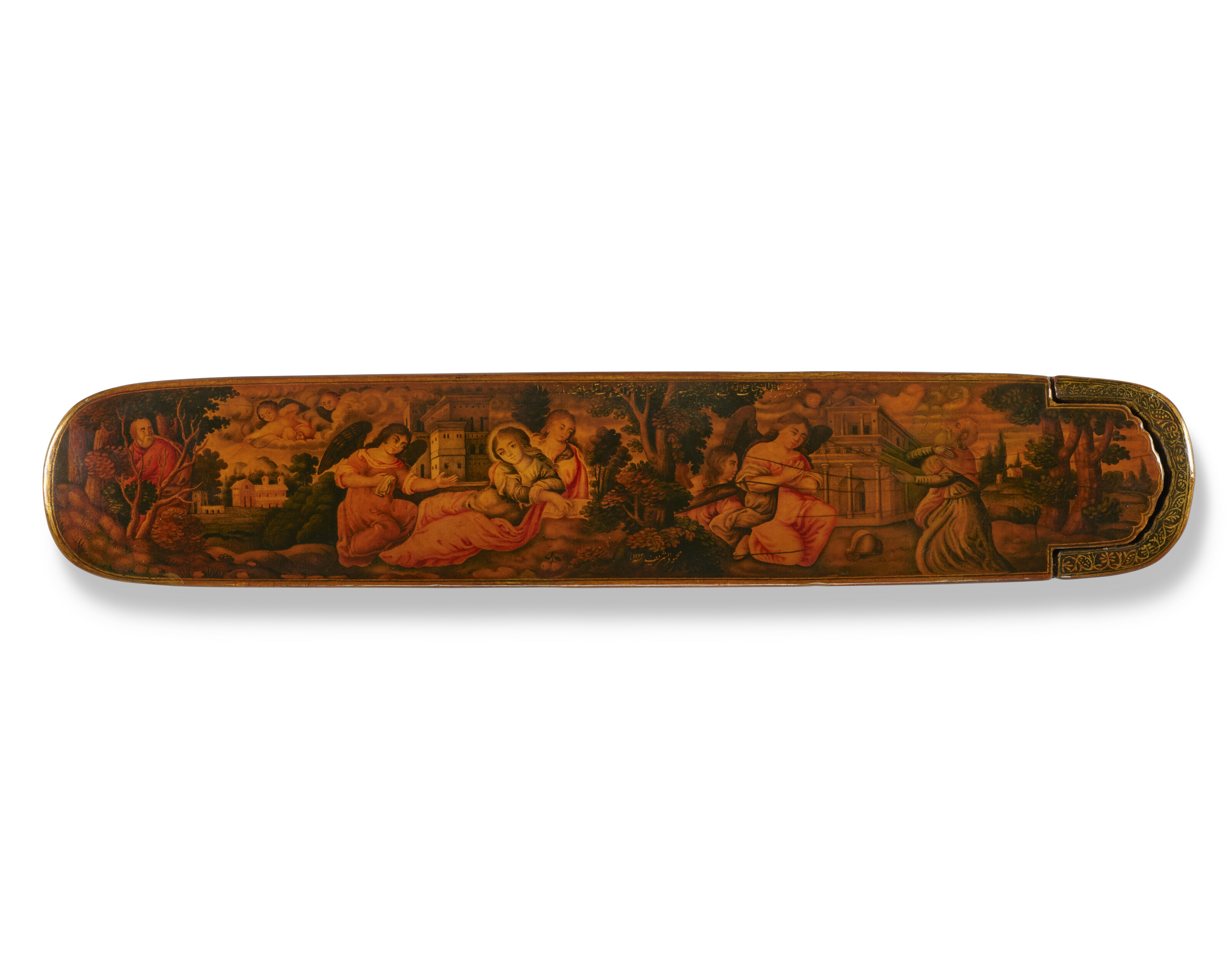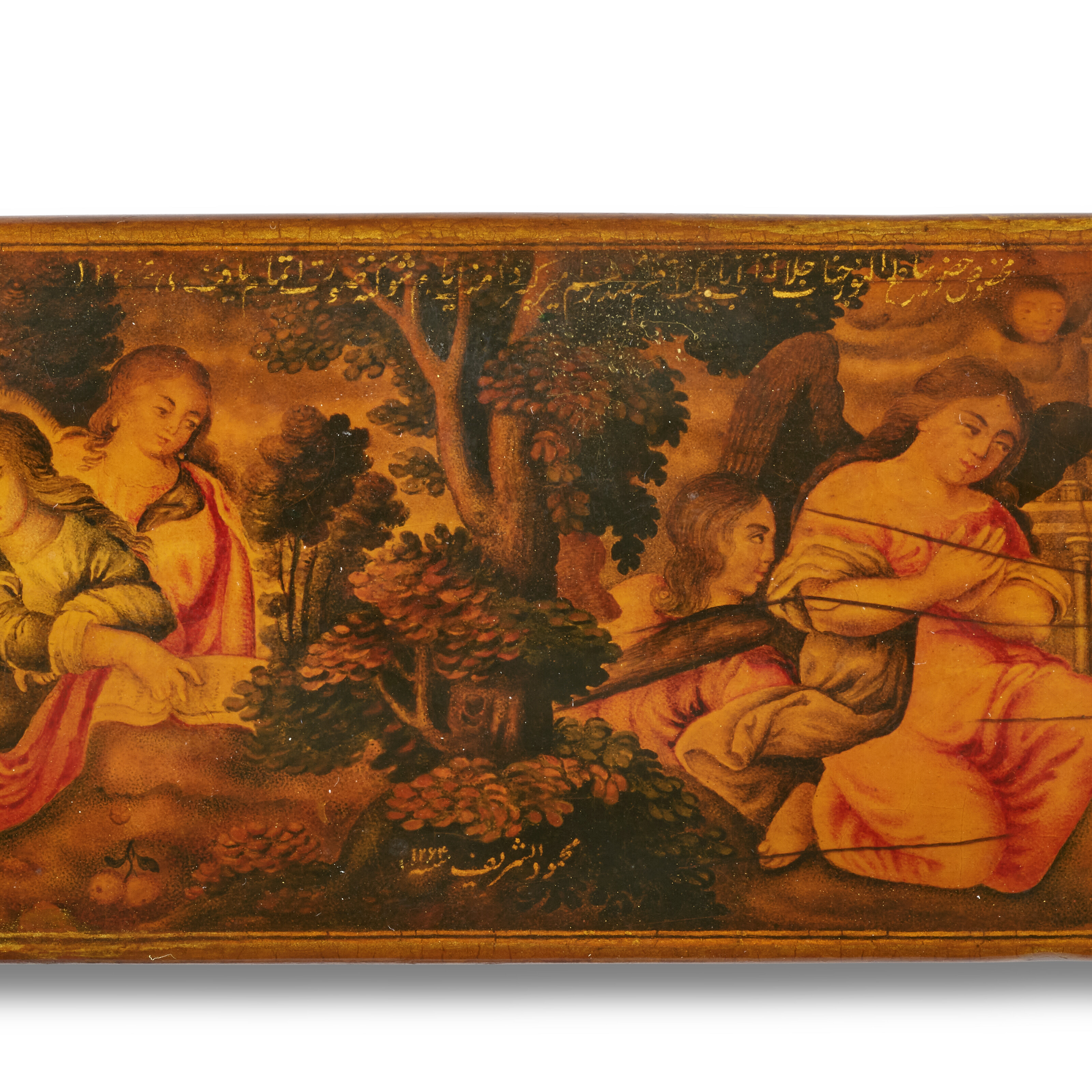- A QAJAR LACQUERED PAPIER-MÂCHÉ PENCASE (QALAMDAN) 1848 - 1849
- Handicrafts and classics, Wood. lacquer
- 24.2 cm
- SIGNED MAHMUD AL-SHARIF, IRAN, DATED AH 1264⁄1848-49 AD
With rounded ends and sliding tray, the top decorated with scenes from the story of Sheikh Sana'an including images of angels and holy figures and with a line of gold inscription along one edge, the sides with pastoral scenes and the underside and vertical edges of the tray with a band of green and gold flowering vine, the top signed Mahmud al-Sharif and dated AH 1264
9 1⁄2in. (24.2cm.) long
Estimation
£3,000
3,948 USD
-
£5,000
6,581 USD
Realized Price
£2,772
3,648 USD
30.7%
Artwork Description
The inscription reads: makhsus-e hozur-e sati' al-nur janab-e atabak-e a'zam sadr-e a'zam amir-e kabir damat ayyam-e shokatihi surat-e etmam padhiroft fi 12[64]
'It was completed especially for the one who radiates light, His Excellency, the repository of grandeur, the most great Minister, the Prime Minister, the Great Amir - may the period of his splendour be ever-lasting - in 12[64] (AD 1848).'
The Prime Minister at the time was Mirza Taqi Khan, known as Amir Kabir, who received all the titles mentioned on this pen-case on 22 Dhu'l-Qa'da AH 1264⁄20 October 1848 AD on Nasir al-Din Shah's arrival to Tehran to ascend to the throne. He is the most respected politician in Iran, the founder of numerous institutions including the Dar al-Funun. Through political intrigues, he was dismissed in AH 1268/November 1851 AD, exiled to Kashan and murdered on 18 Rabi' I AH 1268⁄10 January 1852 AD. (M. Bamdad, Dictionary of National Biography of Iran, 1700-1960, Tehran, 1966, pp. 209-21).
Mahmud al-Sharif was from Qa'in and was a painter of portrait, flower and bird, and landscape. Apart from lacquer, he worked in watercolour and siyah qalam. His recorded lacquered work include three pen-cases dated between AH 1264-1275/1847-59 AD, one depicting Ihtisham al-Dawla the 17th son of 'Abbas Mirza Na'ib al-Sultana, (M.A. Karimzadeh-Tabrizi, The Lives and Art of Old Painters of Iran, vol. 3, London, 1991, pp. 1134-5).
'It was completed especially for the one who radiates light, His Excellency, the repository of grandeur, the most great Minister, the Prime Minister, the Great Amir - may the period of his splendour be ever-lasting - in 12[64] (AD 1848).'
The Prime Minister at the time was Mirza Taqi Khan, known as Amir Kabir, who received all the titles mentioned on this pen-case on 22 Dhu'l-Qa'da AH 1264⁄20 October 1848 AD on Nasir al-Din Shah's arrival to Tehran to ascend to the throne. He is the most respected politician in Iran, the founder of numerous institutions including the Dar al-Funun. Through political intrigues, he was dismissed in AH 1268/November 1851 AD, exiled to Kashan and murdered on 18 Rabi' I AH 1268⁄10 January 1852 AD. (M. Bamdad, Dictionary of National Biography of Iran, 1700-1960, Tehran, 1966, pp. 209-21).
Mahmud al-Sharif was from Qa'in and was a painter of portrait, flower and bird, and landscape. Apart from lacquer, he worked in watercolour and siyah qalam. His recorded lacquered work include three pen-cases dated between AH 1264-1275/1847-59 AD, one depicting Ihtisham al-Dawla the 17th son of 'Abbas Mirza Na'ib al-Sultana, (M.A. Karimzadeh-Tabrizi, The Lives and Art of Old Painters of Iran, vol. 3, London, 1991, pp. 1134-5).
More lots by Unknown Artist

An Isfahan pictorial rug, Central Persia, circa 1910
Estimation
£4,000
5,236 USD
-
£6,000
7,853 USD
Realized Price
£5,670
7,421 USD
13.4%
Sale Date
Sotheby's
-
30 March 2022

A gold medal commemorating the coronation of Muhammad Reza Shah and Queen Farah
Estimation
£100
132 USD
-
£200
263 USD
Realized Price
£160
211 USD
6.667%
Sell at
Sale Date
Rosebery's Auction
-
1 April 2022

A silver memorial medal of the White Revolution, Muhammad Reza Shah, 1967
Estimation
£200
263 USD
-
£300
395 USD
Realized Price
£170
224 USD
32%
Sell at
Sale Date
Rosebery's Auction
-
1 April 2022
Realized Price
69,501 USD
Min Estimate
36,463 USD
Max Estimate
54,751 USD
Average Artwork Worth
+87.283%
Average Growth of Artwork Worth
Sales Performance Against Estimates
Average & Median Sold Lot Value
2018 - 2022
Performance vs. Estimate
2018 - 2022
Sell-through Rate
2018 - 2022
Similar Artworks

A Safavid lacquered papier mache qalamdan, signed 'Ali Riza 'Abbasi, Iran, dated 1095AH (1683-84AD)
Estimation
£600
790 USD
-
£800
1,053 USD
Realized Price
£3,200
4,212 USD
357.143%
Sell at
Sale Date
Rosebery's Auction
-
1 April 2022



